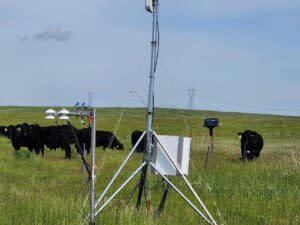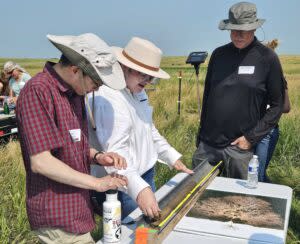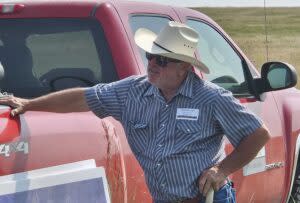Research aims to quantify carbon storage in grasslands

Phillips and her research staff discussed their study of carbon storage in grasslands near McKenzie, North Dakota, on July, 11, 2024. (Jeff Beach/North Dakota Monitor)
McKENZIE, N.D. — A research project in North Dakota is studying underground carbon storage with results that could benefit ranchers.
Rebecca Phillips is leading the project on a ranch in central North Dakota to try to quantify just how much carbon can be stored in the root systems of grasses on a cattle ranch.
Phillips said the project is trying to go beyond measuring carbon in a particular plant or a spot in a pasture.
“What we’re trying to get is a big umbrella number of the total amount of carbon that is coming into this ecosystem on an annual basis,” Phillips said Thursday during a demonstration day on the research at a ranch near McKenzie in Burleigh County.
Quantifying carbon storage on grasslands could help ranchers benefit from carbon storage credits.
Lewis Heaton is the rancher who offered up his land for the study, in part because there are companies willing to pay for offsets.
But he said most of the research on carbon storage in the soil has been on cropland, not grasslands.
“As far as we know, there hasn’t really been a study like this,” Heaton said.
While all plants store carbon, annuals, which would include crops such as wheat, corn and soybeans, tend to store carbon about ground in the plant tissue. Perennials, including grasses, store carbon in their roots.
Some environmentalists point to belching cows as contributing to greenhouse gas emissions. The Environmental Protection Agency notes that researchers have found that 37% of methane emissions from human activity come from livestock and agricultural practices.
Phillips, who has a doctorate in environmental sciences and engineering-biochemistry, sees cows as stimulating natural carbon storage on rangelands.
“It could really change the conversation about beef and cattle,” Phillips said
The project is in the second year of a two-year study. One finding from the research so far is that in pastures that have been grazed by cattle, the grasses store more carbon than if they had been left ungrazed.
“We were finding that oh, that regrowth is picking up more carbon out of the air than the idle pasture that just sat there not being grazed,” Phillips said.
The project is trying to account for a variety of factors that will influence carbon storage.
For example, cows take away carbon as they graze, but also leave some carbon behind in manure.
Phillips has positioned several instruments to gather data in one one of Heaton’s pastures. Data is collected on the amount of sunlight that hits the ground and how much is reflected. There also is a monitor for the amount of carbon dioxide and water vapor in the air and a fancy rain gauge.
Visitors to the research site on Thursday looked at soil samples pulled by a device to show how deep the root systems of grasses can go. Phillips also uses data and maps from satellites.
Phillips is the lead scientist at Ecological Insights, a nonprofit organization based in Hazelton.
The manager for the project is Jesse Beckers of the North Dakota Natural Resource Trust.
Financial backers of the project include the North Dakota Industrial Commission, Hess Corporation, an oil and gas company with a long history in North Dakota, and outdoors agencies and groups.
After collecting two years of data, Phillips will publish the study with the goal of being able to model the results for other ranches.
“We want to be able to help other ranchers understand their carbon better themselves and that’s where some of these mapping products and the modeling would be useful,” Phllips said.
The research could change the way ranchers manage their pastures to promote carbon sequestration.
“It’s a big endeavor,” Phillips said, “but there’s so many satellites out there and there’s so much available now. We just need to figure out the best way to apply it.”
Philips is hoping for funding to extend the study and add equipment that would monitor methane in the air and the presence of methanotrophs – bacteria that feed on methane.
Phillips said grassland soils are rich with methanotrophs.
“We could literally do with methane what we do with carbon dioxide,” Phillips said.
A couple more years of data also would help the carbon sequestration modeling.
“The more years of data, the better the model is,” she said.
GET THE MORNING HEADLINES DELIVERED TO YOUR INBOX SUPPORT NEWS YOU TRUST.
The post Research aims to quantify carbon storage in grasslands appeared first on North Dakota Monitor.




